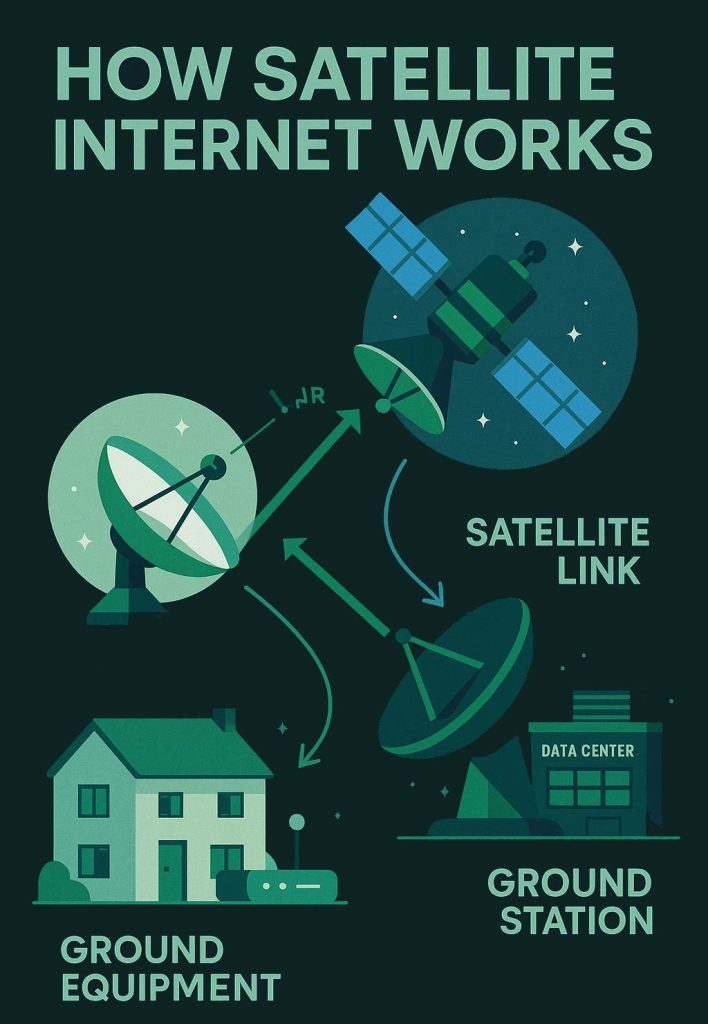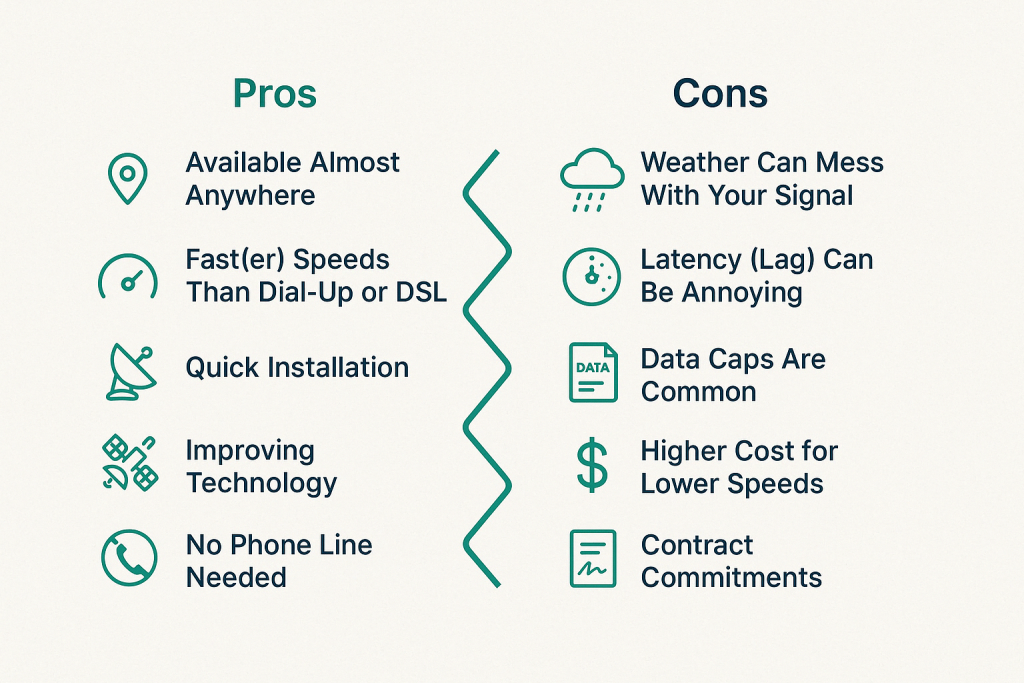Written By: David Cosseboom | Updated On: June 19th, 2025
Key Takeaways
- Satellite internet is perfect for rural or remote areas, offering reliable connectivity where traditional options like cable or fiber aren’t available.
- Speeds have significantly improved, with providers like Starlink offering faster, lower-latency connections, making everyday online tasks easier and more enjoyable.
- Be mindful of latency and data caps, as satellite internet works best for general browsing and streaming, but might not be ideal for heavy gaming or frequent large downloads.
What is Satellite Internet?
Satellite internet is a unique type of internet service that connects you online through satellites orbiting high above the Earth. Imagine being able to access the internet from practically anywhere, even places where traditional cable or fiber optic connections aren’t available. Satellite internet accomplishes exactly that by bouncing signals between your home, a satellite dish, and satellites orbiting Earth. It’s especially helpful for people living in rural, remote, or underserved areas, making it possible for everyone to enjoy the benefits of being connected.
Benefits of Satellite Internet
Satellite internet provides several unique advantages, especially valuable to users in areas where cable, DSL, or fiber optic connections aren’t feasible. It’s an excellent solution for rural residents, travelers, or anyone located far from typical broadband infrastructure. Satellite internet delivers connectivity even in remote locations, ensuring consistent access regardless of geographic isolation.
- Wide Availability: Satellite internet reaches virtually any location with a clear view of the sky, making it accessible even in the most isolated regions.
- Reliable Connectivity: It operates independently of local terrestrial networks, reducing the impact of regional outages or infrastructure issues.
- Easy Setup: Installation typically involves mounting a dish and connecting a modem, making setup straightforward and fast compared to more complex wired installations.
How Fast is Satellite Internet?
Internet speed is a crucial factor when selecting a provider. Historically, satellite internet was known for slow speeds, but recent technological advancements have significantly enhanced its performance. Today, satellite internet speeds can comfortably accommodate common household activities like streaming, browsing, and working remotely. Satellite internet speeds typically range from 25 Mbps to over 150 Mbps, depending on the provider and plan chosen. Higher-end packages from providers like Starlink can offer even greater speeds, approaching or surpassing traditional broadband services.
How Does Satellite Internet Work?

Satellite internet relies on a sophisticated communication process involving multiple steps and components. Understanding this process provides insight into both its functionality and its limitations, such as latency or weather-related disruptions. Satellite internet works by transmitting signals between your home’s satellite dish, a satellite orbiting Earth, and a network operations center (NOC) or ground station. When you request data, like opening a website, the request travels from your device through your satellite dish to an orbiting satellite, then down to the NOC. The NOC retrieves the data from the internet, sends it back up to the satellite, which then beams it down to your dish, delivering the information back to your device.
Components of a Satellite Network
Satellite internet networks are built from interconnected components that each play a critical role in ensuring reliable connectivity. These parts work together seamlessly to facilitate high-speed internet access from space directly to your home.
- Satellite Dish: Installed at your home, it captures and sends signals to and from orbiting satellites.
- Orbiting Satellite: Typically positioned in geostationary orbit (approximately 22,000 miles above Earth), it acts as a relay, receiving and sending data between your dish and the network center.
- Network Operations Center (NOC): A ground-based facility where internet traffic is managed, and requests are processed and routed.
- Modem/Router: A device within your home that converts satellite signals into internet connectivity usable by your devices.
Satellite Internet Installation Process
Installing satellite internet typically involves a few key steps and is generally straightforward. First, a certified technician will visit your property to determine the optimal location for the satellite dish, ensuring an unobstructed view of the southern sky. The technician then securely mounts the satellite dish, properly aligns it to receive the strongest signal, and runs cables from the dish to your home. Finally, the technician connects and configures the modem or router, sets up your wireless network, and tests the connection to ensure everything is working correctly. The entire process usually takes between two to three hours.
Pros and Cons of Satellite Internet
Satellite internet is a game-changer for many people, but like any technology, it has its strengths and limitations. Here’s a balanced look at the pros and cons, so you can decide if it’s the right fit for you!

The Pros: Why Satellite Internet Rocks
- Available Almost Anywhere
Unlike cable or fiber, satellite internet works in remote, rural, and off-grid areas, as long as you have a clear view of the sky. No more waiting for infrastructure upgrades! - Fast(er) Speeds Than Dial-Up or DSL
Modern satellite internet (like Starlink or HughesNet V3) offers decent speeds (often 25–200 Mbps), making it way better than old-school dial-up or sluggish DSL. - Quick Installation
No digging or lengthy installations, just set up a dish, sync with the satellite, and you’re online. Some systems are even portable for RVers and travelers! - Improving Technology
New low-orbit satellites (like Starlink’s) are reducing latency, making video calls, streaming, and even gaming more feasible than with old geostationary satellites. - No Phone Line Needed
Unlike DSL, satellite internet doesn’t rely on landlines, so it’s a great option where phone infrastructure is outdated or nonexistent.
The Cons: The Not-So-Great Stuff
- Weather Can Mess With Your Signal
Heavy rain, snow, or even thick clouds can disrupt service—though newer systems handle weather better than older ones. - Latency (Lag) Can Be Annoying
Even with improvements, satellite internet still has higher latency than fiber or cable. That means:- Gamers: Fast-paced online games (like Fortnite or Call of Duty) may feel laggy.
- Video calls: Occasional delays or frozen screens.
- Data Caps Are Common
Many satellite plans have monthly data limits (e.g., 50–150GB). If you stream a lot or have a big household, you might hit the cap and experience slower speeds afterward. - Higher Cost for Lower Speeds
Compared to urban cable/fiber plans, satellite internet is often more expensive for slower speeds. Installation and equipment fees can also add up. - Contract Commitments
Some providers require 1–2 year contracts, and early termination fees can be steep. (Though Starlink is a nice exception—no contracts!)
Who Should Get Satellite Internet?
Not everyone has the luxury of fast, reliable internet, but that doesn’t mean you should have to settle for slow speeds or no connection at all! Satellite internet is changing the game, especially for folks who’ve been stuck with limited (or zero) options. Whether you’re living off-grid, working remotely from a cozy cabin, or just tired of spotty service, satellite internet could be your ticket to staying connected. Satellite internet might be ideal if:
1. Rural & Remote Areas
If you live way out in the countryside, miles from the nearest cable or fiber connection, satellite internet might be your best (or only) shot at reliable high-speed internet. No more waiting for infrastructure that may never come, just point that dish at the sky, and you’re online!
2. Frequent Travelers & Nomads
RV life? Boat life? Always on the move? Modern satellite internet (especially newer services with portable dishes) means you can get solid internet even in the middle of nowhere. No more hunting for sketchy campground Wi-Fi!
3. Emergency Backup Users
If storms, outages, or natural disasters often knock out your internet, having satellite as a backup keeps you connected when everything else fails. Super handy for remote workers or anyone who needs to stay online.
4. Off-Grid Lovers
Living the cabin-in-the-woods dream? Satellite internet lets you stay connected without needing to be tied to traditional utilities. Perfect for digital nomads, homesteaders, or anyone who values independence.
5. Gamers & Streamers (With Realistic Expectations)
Okay, full transparency, satellite internet isn’t ideal for super competitive gaming (latency can be a thing). But if you’re in a rural area and just want to stream movies or play casual games, newer satellite tech is making it way better than before!
Who Might Not Need It?
If you’ve got affordable fiber or cable where you live, stick with that—it’ll usually be faster and cheaper. But for everyone else? Satellite internet can be a total game-changer.
The Major Satellite Internet Providers: Which One’s Right for You?
If you’re considering satellite internet, you’ve got a few key players to choose from, each with its own strengths and quirks.
1. Starlink (by SpaceX)
Best for speed, low latency, and portability
Why it stands out:
- Uses low Earth orbit (LEO) satellites, meaning faster speeds (50–200 Mbps) and lower lag than traditional satellite internet.
- No hard data caps (though some plans may deprioritize heavy users during peak times).
- Great for RVers, boaters, and travelers—their portable “Standard” and “Mini” dishes let you take internet on the go.
Potential downsides:
- Higher upfront cost ($599 for hardware, plus $120–$250/month for service).
- Waitlists in some areas (though coverage is expanding fast!).
Best for: Rural users, remote workers, digital nomads, and anyone who wants the closest thing to broadband via satellite.
2. HughesNet
A reliable (but slower) choice for basic internet
Why people choose it:
- Nationwide availability—works almost anywhere in the U.S.
- No throttling (speeds stay consistent, but data is capped).
- More affordable plans (starting around $65/month).
Potential downsides:
- Slower speeds (25 Mbps max) and high latency (not ideal for gaming or video calls).
- Strict data caps (15–100GB/month, with slowed speeds afterward).
- 2-year contract required (early termination fees apply).
Best for: Light internet users in remote areas who just need email, browsing, and occasional streaming.
3. Viasat (formerly Exede)
Faster than HughesNet, but pricier
Why it’s different:
- Offers higher-speed plans (up to 150 Mbps in some areas).
- More data flexibility (some plans include extra “bonus data” during off-peak hours).
Potential downsides:
- Prices can get steep ($70–$300/month, depending on speed and data needs).
- Still has latency issues (better than HughesNet but not as good as Starlink).
- Contracts required (usually 2 years).
Best for: Households that need more data than HughesNet offers but don’t have Starlink availability.
4. Project Kuiper (Amazon’s Upcoming Service)
What we know so far:
- Amazon plans to launch 3,236 LEO satellites (similar to Starlink).
- Promises high speeds, low latency, and global coverage.
- Beta testing expected in 2025, with full rollout later.
Why it matters:
- Could bring more competition (and lower prices) to satellite internet.
- Might integrate with Amazon Prime/AWS services (speculation for now).
How Do They Compare?
| Provider | Max Speed | Latency | Data Policy | Contracts | Best For |
|---|---|---|---|---|---|
| Starlink | 50–200 Mbps | Low (~20–50ms) | No hard caps | None | Speed, mobility, rural users |
| HughesNet | 25 Mbps | High (~600ms+) | Strict caps | 2-year | Basic browsing, email |
| Viasat | Up to 150 Mbps | Moderate (~500ms) | Capped, bonus data | 2-year | More data than HughesNet |
| Kuiper | TBD (likely 100+ Mbps) | Likely low | TBD | TBD | Future alternative |
Final Verdict: Which Should You Pick?
- Need the best performance? Starlink (if available).
- On a budget and don’t need speed? HughesNet.
- Want more data than HughesNet? Viasat.
- Willing to wait? Keep an eye on Project Kuiper.
How Starlink is Different from Traditional Satellite Internet
Starlink represents a significant innovation in satellite internet technology, distinctly differing from traditional providers. Traditional satellite services use geostationary satellites placed approximately 22,000 miles above Earth, resulting in higher latency. In contrast, Starlink employs a constellation of low Earth orbit (LEO) satellites at altitudes around 340 miles, dramatically reducing latency and enhancing performance. Additionally, Starlink typically offers more generous or even unlimited data allowances compared to traditional satellite internet providers.
Limitations of Satellite Internet
While beneficial, satellite internet has specific limitations worth considering. These factors can impact your experience and may affect the suitability of satellite internet for certain uses or environments.
- Latency Issues: Not suitable for applications requiring real-time interaction, such as gaming or video conferencing.
- Data Caps: Providers often impose monthly data limits, restricting heavy usage such as frequent streaming or large downloads.
- Weather Interference: Heavy rain, snow, or cloud cover can temporarily disrupt satellite signals.
How Does Satellite Internet Stack Up to Other Technologies
When it comes to internet options, not all technologies are created equal. Satellite internet fills a crucial gap, but how does it stack up against fiber, cable, DSL, and 5G?
| Type | Speed | Latency | Data Caps | Availability | Best For |
|---|---|---|---|---|---|
| Satellite | 25–200 Mbps | High | Often capped | Everywhere | Rural, remote areas |
| Fiber | 500 Mbps–2 Gbps+ | Very low | Rarely | Limited (cities) | Gamers, streamers |
| Cable | 100–1,000 Mbps | Low | Sometimes | Urban/suburban | Families, WFH |
| DSL | 5–100 Mbps | Medium | Rarely | Some rural areas | Budget users |
| 5G Home | 50–300 Mbps | Low | Rarely | Near 5G towers | Simple, no-install |
- Fiber Internet: Offers significantly faster speeds, lower latency, and unlimited data, ideal for heavy internet users but generally restricted to urban and suburban regions.
- Cable Internet: Delivers faster speeds and lower latency compared to satellite, more reliable overall, but limited to areas served by cable infrastructure.
- 5G Home Internet: Provides fast speeds with low latency in areas where 5G coverage is available, but its service range is typically limited compared to satellite internet.
Satellite internet offers a valuable solution where traditional broadband is unavailable, ensuring connectivity regardless of location and helping you stay reliably connected.
Is satellite internet as fast as cable or fiber?
Does weather affect satellite internet?
Are there data caps with satellite internet?
Can I use satellite internet for gaming or Zoom calls?
How much does satellite internet cost?
Can I take satellite internet on the road?
About the Author
David has been an integral part of some of the biggest utility sites on the internet, including InMyArea.com, HighSpeedInternet.com, BroadbandNow.com, and U.S. News. He brings over 15 years of experience writing about, compiling and analyzing utility data.
